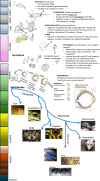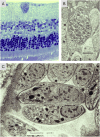Evolution of the ocular immune system
- PMID: 39653763
- PMCID: PMC11794555
- DOI: 10.1038/s41433-024-03512-4
Evolution of the ocular immune system
Abstract
The evolution of the ocular immune system should be viewed within the context of the evolution of the immune system, and indeed organisms, as a whole. Since the earliest time, the most primitive responses of single cell organisms involved molecules such as anti-microbial peptides and behaviours such as phagocytosis. Innate immunity took shape ~2.5 billion years ago while adaptive immunity and antigen specificity appeared with vertebrate evolution ~ 500 million years ago. The invention of the microscope and the germ theory of disease precipitated debate on cellular versus humoral immunity, resolved by the discovery of B and T cells. Most recently, our understanding of the microbiome and consideration of the host existing symbiotically with trillions of microbial genes (the holobiont), suggests that the immune system is a sensor of homoeostasis rather than simply a responder to pathogens. Each tissue type in multicellular organisms, such as vertebrates, has a customised response to immune challenge, with powerful reactions most evident in barrier tissues such as the skin and gut mucosa, while the eye and brain occupy the opposite extreme where responses are attenuated. The experimental background which historically led to the concept of immune privilege is discussed in this review; however, we propose that the ocular immune response should not be viewed as unique but simply an example of how the tissues variably respond in nature, more or less to the same challenge (or danger).
© 2024. The Author(s).
Conflict of interest statement
Competing interests: The authors declare no competing interests.
Figures




References
-
- Gest H. Homage to Robert Hooke (1635-1703): new insights from the recently discovered Hooke Folio. Perspect Biol Med. 2009;52:392–9. - PubMed
-
- Brogren CH. Louis Pasteur-The life of a controversial scientist with a prepared mind, driven by curiosity, motivation, and competition. APMIS. 2024;132:7–30. - PubMed
-
- Mendelsohn JA. ‘Like all that lives’: biology, medicine and bacteria in the age of Pasteur and Koch. Hist Philos Life Sci. 2002;24:3–36. - PubMed
-
- Gordon S. Elie Metchnikoff: father of natural immunity. Eur J Immunol. 2008;38:3257–64. - PubMed
Publication types
MeSH terms
LinkOut - more resources
Full Text Sources
Medical

